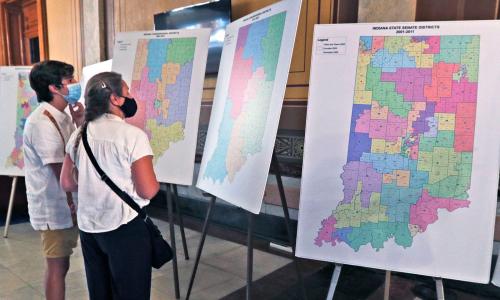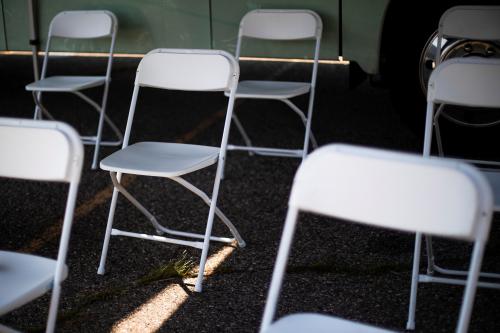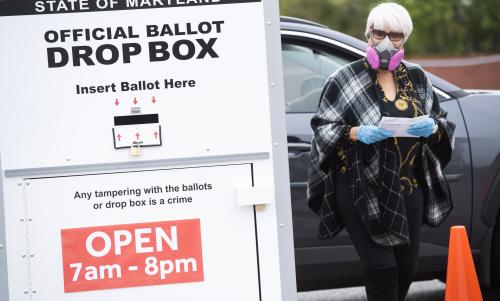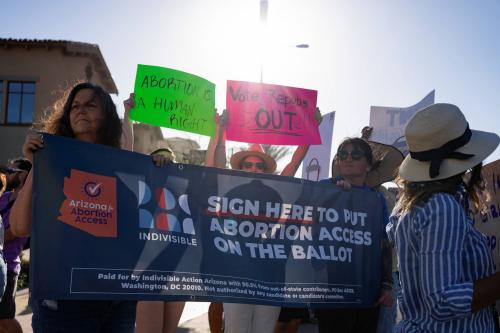This year has seen a flurry of activity in state legislatures as they enacted laws that either made it easier or harder to vote. Now that many legislatures have finished their work the question is—so what? The story is, as usual, more complicated than the headlines. In some states, election reforms won’t make much of a difference. As we will see, solidly red states tended to pass restrictive voting laws and solidly blue states tended to pass expansive voting laws. But in swing states, where the presidential race or the balance of power in Congress could be won, the attempts to expand or restrict the vote could matter greatly.
The attention to election law reform began in 2020 as states struggled to hold an election in the middle of a pandemic. The result was that states adopted an unprecedented degree of innovation in dealing with absentee ballots and early voting. Millions of Americans adjusted fairly easily to the new ways of casting votes. On election day, nearly half of all Americans voted remotely in one way or the other.
Well before Election Day, former President Trump was attacking these voting innovations—asserting, among other things, that foreign countries would be able to print ballots and mail them in. In the aftermath of the 2020 election, Trump’s relentless assault on the integrity of the election continued, and in that year, state legislatures considered an unprecedented amount of voting legislation. Most of the attention has been given to new laws which suppress the vote, but other legislation has, in fact, made permanent innovations that were adopted to deal with the challenges of the pandemic.
Thanks to the work of the Brennan Center and its compilation, “Voting Laws Roundup: October 2021,” we know that 19 states have passed laws making it harder to vote. Many of these changes targeted early voting and absentee ballots and are a direct result of the fact that Donald Trump started complaining that these systems would be vulnerable to corruption months before Election Day. Although there were no instances of widespread fraud in either absentee ballots or early voting, Republicans in these states have pursued reforms as if there were. Often these states garnered headlines for their sheer pettiness and racism. While the effort to make “souls to the polls”[1] illegal in Georgia failed, the state did make it illegal to pass out snacks or water to people waiting in line to vote. In Florida, supervisors are required to assign an employee to monitor drop boxes for early ballots and the law limits the use of drop boxes to early voting hours. Many states made it harder to get absentee ballots and imposed stricter voter identification requirements.
On the other hand, according to the Brennan Center, 25 states passed laws making it easier to vote. Most of the changes made voting by mail easier and expanded opportunities for early voting. In California, the law passed now requires that all voters receive a ballot by mail. Previously, this had been up to county officials. The law now extends this to all elections and all local officials. In Maryland, voters can now choose to get ballots in the mail forever without having to request an absentee ballot for every election.
But some states adopted a mix of laws; some make voting easier and some make it more difficult. Take the case of Indiana, a very Republican state. Its reforms dealt primarily with how ballots were counted. Indiana laws limited the availability of voter drop boxes while at the same time making it easier to vote by mail. In New York, a very Democratic state, the legislature required that voters get their absentee ballot applications submitted 15 days before an election instead of seven days. On the other hand, the state adopted “no excuse” absentee balloting—meaning the voter does not have to offer an excuse for requesting an absentee ballot.
So, what will be the political effect of these new laws on the upcoming elections? One way to look at this is to divide the changes into states where the laws passed are clearly restrictive, states where the laws passed are clearly expansive, and states where the laws are mixed. Table #1 provides a quick look at the likely impact of restrictive voting laws in 11 states. Some states on this list, like Alabama for instance, are so Republican that the restrictive laws are likely to have little impact on outcomes. But Arizona, Florida, and Georgia, where presidential election results were very close, will have Senate races and as many as seven House races that are likely to be high profile and somewhat competitive as of now. Who votes in 2022 is of critical importance to the balance of power in Congress.
Table #1: States with new restrictive voting laws
| State | Electoral Votes | Possible Change in Senate Seat 2022 | Possible Change in House Seats 2022 |
| AL | 9 | Solid R | 1 seat at slight risk |
| AR | 6 | Solid R | No seats at risk or minimal risk |
| AZ | 11 | Lean D | 2 seats at slight risk, 2 seats at moderate to high risk |
| FL | 30 | Lean R | 1 seat at slight risk, 2 seats at moderate to high risk |
| GA | 16 | Lean D | 1 seat at slight risk, 2 seats at moderate to high risk |
| IA | 6 | Solid R | 3 seats at slight risk |
| ID | 4 | Solid R | No seats at risk or minimal risk |
| KS | 6 | Solid R | 1 seat at slight risk |
| TX | 40 | N/A | 1 seat at moderate to high risk |
| UT | 6 | Solid R | No seats at risk or minimal risk |
| WY | 3 | N/A | No seats at risk or minimal risk |
| Sources: Cook Political Report Senate Race Ratings; Cook Political Report House Incumbents Most at Risk | |||
Table #2 charts results for states with mixed changes in their voting laws. In the presidential contest, all these states except for New Hampshire went for Trump, and in the Senate races, only New Hampshire has a competitive race so far. However, in the House races, there could be as many as seven seats in the “moderate to high risk” column.
Table #2: States with new mixed result voting laws
| State | Electoral Votes | Possible Change in Senate Seat 2022 | Possible Change in House Seats 2022 |
| IN | 11 | Solid R | No seats at risk or minimal risk |
| KY | 8 | Solid R | 1 seat at moderate to high risk |
| LA | 8 | Solid R | 3 seats at slight risk |
| OK | 7 | Solid R | No seats at risk or minimal risk |
| MT | 4 | N/A | No seats at risk or minimal risk |
| NH | 4 | Lean D | 1 seat at moderate to high risk |
| NY | 28 | Solid D | 6 seats at slight risk, 5 seats at moderate to high risk |
| NV | 6 | Lean D | No seats at risk or minimal risk |
| Sources: Cook Political Report Senate Race Ratings; Cook Political Report House Incumbents Most at Risk | |||
Lastly, Table #3 lists states that expanded voting through their reforms. A quick glance shows that most of these states are Democratic. In 2020, only North Dakota went for Trump. It’s possible but unlikely that these laws will affect the Senate seats since so many of them are solidly Democratic. But there are seven House seats that are at “moderate to high risk” of changing parties and 29 seats at “slight risk” of changing parties.
Table #3: States with new expansive voting laws
| State | Electoral Votes | Possible Change in Senate Seat 2022 | Possible Change in House Seats 2022 |
| CA | 54 | Solid D | 15 seats at slight risk, 2 seats at moderate to high risk |
| CO | 10 | Solid D | 3 seats at slight risk |
| CT | 7 | Solid D | No seats at risk or minimal risk |
| DE | 3 | N/A | No seats at risk or minimal risk |
| HI | 4 | Solid D | No seats at risk or minimal risk |
| IL | 19 | Solid D | 1 seat at slight risk, 2 seats at moderate to high risk |
| MA | 11 | N/A | No seats at risk or minimal risk |
| MD | 10 | Solid D | 1 seat at moderate to high risk |
| ME | 4 | N/A | No seats at risk or minimal risk |
| MN | 10 | N/A | 1 seat at slight risk |
| ND | 3 | Solid R | No seats at risk or minimal risk |
| NJ | 14 | N/A | 4 seats at slight risk, 1 seat at moderate to high risk |
| NM | 5 | N/A | 1 seat at moderate to high risk |
| OR | 8 | Solid D | 1 seat at slight risk |
| VA | 13 | N/A | 3 seats at slight risk |
| VT | 3 | Solid D | No seats at risk or minimal risk |
| WA | 12 | Solid D | 1 seat at slight risk |
| Sources: Cook Political Report Senate Race Ratings; Cook Political Report House Incumbents Most at Risk | |||
What these charts make clear is that restrictive laws have largely passed in Republican states and expansive ones in Democratic states. But perhaps even more important is what is missing. Michigan, for instance, isn’t in this analysis because as of early October, the Republican-controlled legislature passed a very restrictive bill that the Democratic Governor vows to veto.
At the presidential level, the effect of these changes will be felt in the handful of states (of which Michigan is one) that are most competitive in presidential elections. Voter suppression laws can hurt the Democrats and help the Republicans in states like Arizona, Florida, and Georgia, where legislative political power is still in the hands of Republicans, but population growth—and thus new voters—tends to be in Democratic areas. Voter expansion laws may not be critical to Democratic victories in California or Massachusetts, but they may help keep Virginia Democratic in a presidential election. The effect in the Senate could be minimal given that so many of the Senate seats up this year are very safe. But in the House, where the Democratic majority is very close, changes in the voting laws could be crucial.
In states that haven’t changed their voting laws, time is running short. Some legislatures may still battle it out, perhaps making no changes at all or making changes that cancel each other out. Others will not. In the end, who votes is likely to have especially big consequences for all elections.
Footnote:
[1] “Souls to the polls” refers to the practice where African American ministers would lead their congregations to early voting sites after Sunday services.







Commentary
Voter suppression or voter expansion? What’s happening and does it matter?
October 26, 2021